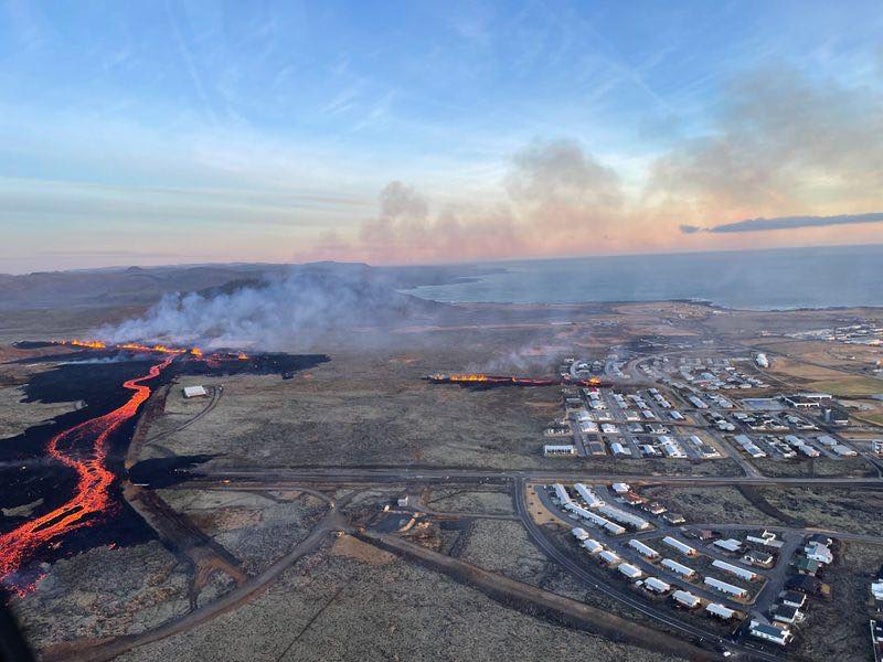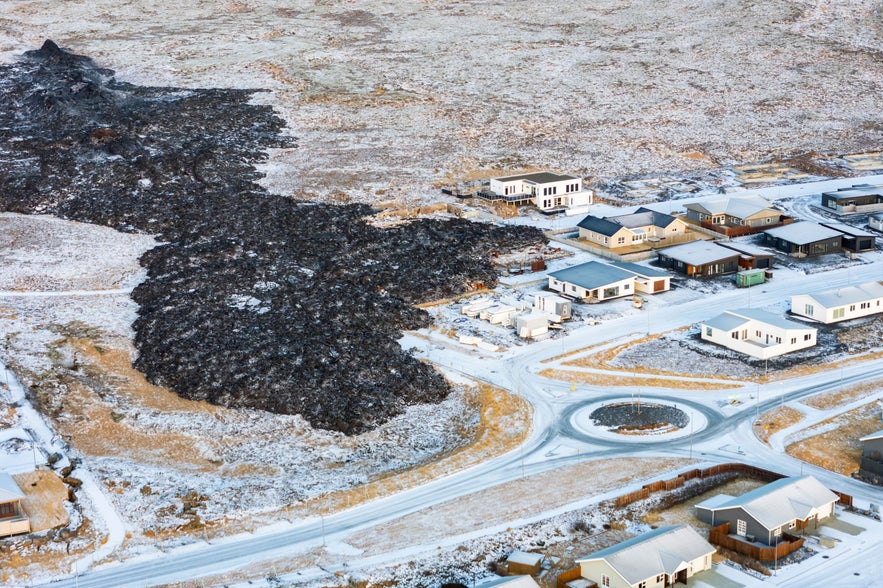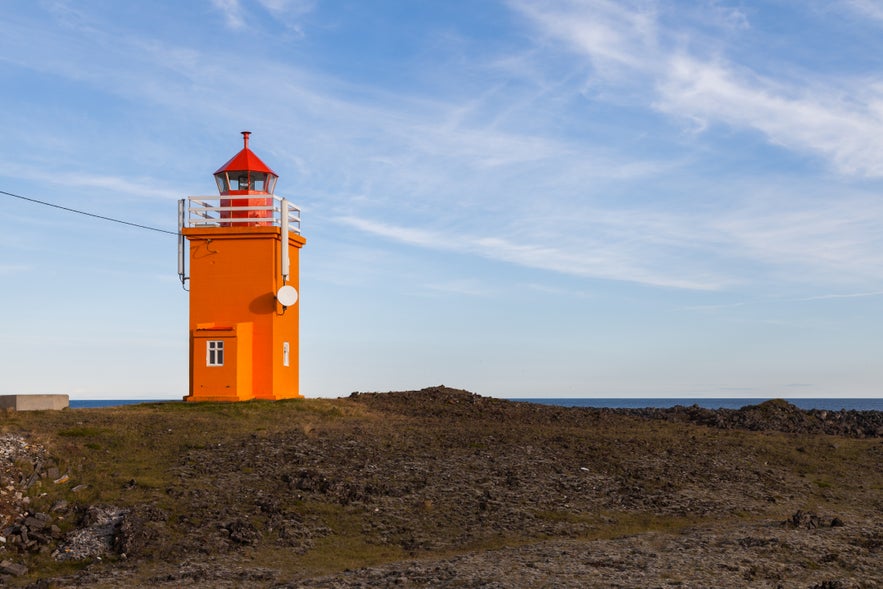
Grindavik ist ein kleines Fischerdorf an der Südküste der isländischen Reykjanes-Halbinsel. Die Stadt ist eng mit dem Meer verbunden und lebt seit jeher von der Fischerei. Grindavik ist von rauen Lavafeldern umgeben und liegt in der Nähe des Mittelatlantischen Rückens, wo zwei tektonische Platten aufeinandertreffen.
Aufgrund dieser besonderen Lage befindet sich Grindavik im Herzen einer geologisch aktiven Region. Diese wird oft bei Reykjanes-Touren vorgestellt, die die geothermalen Landschaften der Halbinsel zeigen. In den letzten Jahren kam es in der Umgebung zu erneuten Vulkanausbrüchen, darunter Eruptionen nahe der Sundhnukagigar-Kraterreihe, die das Leben in der Region zeitweise beeinträchtigten.
Warum du unseren Inhalten vertrauen kannst
Guide to Iceland ist die vertrauenswürdigste Reiseplattform Islands und hilft jedes Jahr Millionen von Besuchern. Alle Inhalte werden von lokalen Experten erstellt und geprüft, die Island in- und auswendig kennen. So kannst du dich auf zuverlässige, aktuelle und präzise Reisetipps verlassen.
Diese Ereignisse haben Grindavik zu einem Ausgangspunkt für Vulkan-Touren gemacht, bei denen Besucher die dramatischen Landschaften der Region hautnah erleben können. Eine Möglichkeit ist die Grindavik- und Krysuvik-Vulkan-Tour, die Stopps an aktiven Spalten und geothermischen Orten beinhaltet.
Grindavík liegt nicht nur inmitten vulkanischer Besonderheiten, sondern auch nur eine kurze Autofahrt vom Flughafen Keflavík und der weltberühmten Blauen Lagune entfernt. Die Stadt ist oft Teil von Island-Reisepaketen, die sich auf die geothermalen und vulkanischen Landschaften der Reykjanes-Halbinsel konzentrieren.
Wichtige Fakten auf einen Blick
-
Aktive Vulkanregion: Grindavik liegt in einer der geologisch aktivsten Zonen Islands. Die jüngsten Ausbrüche nahe der Sundhnukagígar-Kraterreihe bieten eine seltene Gelegenheit, sich verändernde Vulkanlandschaften zu erleben.
-
Nähe zu Top-Attraktionen: Die Stadt ist nur eine kurze Fahrt von der Blauen Lagune und dem internationalen Flughafen Keflavik entfernt.
-
UNESCO Global Geopark: Die Vereinten Nationen haben die Reykjanes-Halbinsel 2015 als UNESCO Global Geopark ausgezeichnet und damit ihre besondere geologische Bedeutung anerkannt.
-
Beste Reisezeit: Der Sommer ist ideal für einen Besuch, mit mildem Wetter, langen Tagen und der Möglichkeit, im berühmten geothermischen Bad der Stadt zu entspannen.
Vulkanische Aktivität und Evakuierungen in Grindavik

Der Vulkanausbruch bei Grindavik am 14. Januar 2024.
Grindavik geriet Ende 2023 weltweit in die Schlagzeilen, als die Bewohner evakuiert werden mussten, nachdem Magma nur wenige Meter unter der Oberfläche festgestellt worden war.
Ein Ausbruch entlang der Sundhnukagígar-Kraterreihe am 18. Dezember 2023 verschonte die Stadt, doch Wissenschaftler warnten, dass sich unterirdisch weiteres Magma ansammeln könnte, das möglicherweise einen erneuten Ausbruch auslöst.
Im Januar 2024 öffnete sich eine Spalte nahe dem Hagafell-Berg und schickte Lava in den Norden von Grindavik, wobei mehrere Häuser beschädigt wurden. Es folgten weitere Ausbrüche in der Sundhnukagigar-Kraterreihe, die jedoch kaum Auswirkungen auf die Stadt hatten.
 Trotz der nahegelegenen Ausbrüche auf der Reykjanes-Halbinsel in den letzten Jahren blieb Grindavik weitgehend von den Lavaströmen verschont. Die Stadt ist von Schutzwällen umgeben, die sich als entscheidend erwiesen haben. Die Behörden überwachen die seismische Aktivität genau und beschränken den Zugang bei Bedarf.
Trotz der nahegelegenen Ausbrüche auf der Reykjanes-Halbinsel in den letzten Jahren blieb Grindavik weitgehend von den Lavaströmen verschont. Die Stadt ist von Schutzwällen umgeben, die sich als entscheidend erwiesen haben. Die Behörden überwachen die seismische Aktivität genau und beschränken den Zugang bei Bedarf.
Grindavik ist weiterhin für Besucher geöffnet, doch man sollte vorsichtig sein. Auch wenn die Lava keine größeren Schäden angerichtet hat, stellen Erdspalten und anhaltende seismische Aktivität weiterhin Risiken dar. Der Boden kann sich unerwartet verschieben, und Risse können direkt unter der Oberfläche verlaufen – daher immer die Sicherheitshinweise und Warnschilder beachten.
Sei versichert: Island bleibt ein sicheres Reiseziel. Das umfassende Überwachungssystem des Landes sorgt für die Sicherheit von Einheimischen und Reisenden. Du kannst Islands beeindruckende Landschaften, Sehenswürdigkeiten und einzigartige Erlebnisse weiterhin unbesorgt genießen.
Aktivitäten rund um Grindavik

Die Region rund um Grindavík mit ihren beeindruckenden Landschaften und ihrer reichen Geschichte hat für jeden etwas zu bieten – von Naturliebhabern bis zu Geschichtsinteressierten. Es gibt zahlreiche Aktivitäten für Reisende jeden Alters und Fitnesslevels.
-
Blaue-Lagune-Spa-Erlebnis: Islands berühmteste Attraktion, die Blaue Lagune, ist ein geothermales Bad mit mineralreichem Wasser, das Entspannung und Hautgesundheit fördert. Reserviere deinen Eintritt in die Blaue Lagune im Voraus und entdecke die besonderen Wellness-Angebote.
-
Krysuvik und Gunnuhver: Auch wenn man in diesen geothermischen Gebieten nicht baden kann, sind sie wunderschöne Ausflugsziele mit blubbernden heißen Quellen, Fumarolen und Schlammtöpfen.
-
Brücke zwischen den Kontinenten: Diese Hängebrücke symbolisiert den Mittelatlantischen Rücken – Besucher können hier zwischen der nordamerikanischen und eurasischen Platte spazieren.
-
Schwimmbad Grindavik: Im Sommer können Touristen das moderne öffentliche Schwimmbad der Stadt besuchen – mit Whirlpools, Kinderbecken, Wasserrutsche und weiteren Attraktionen.
-
Selatangar-Fischereistation: Nur 14 Kilometer von Grindavik entfernt können Besucher die Ruinen einer Fischereistation besichtigen, die vom 14. bis zum 19. Jahrhundert betrieben wurde.
-
Brimketill-Lava-Felsenpool: Der Legende nach badete und wusch die Trollfrau Oddný in diesem beeindruckenden vulkanischen Felsenpool an der Küste ihre Kleidung.
-
Hopsnes-Leuchtturm: Der leuchtend orange-rote Leuchtturm ist Grund genug, die Hopsnes-Halbinsel zu besuchen – nur 4 Kilometer von Grindavik entfernt.
Anreise nach Grindavik
 Grindavik liegt 42 Kilometer vom Flughafen Keflavik entfernt und ist ein idealer erster Stopp, bevor es nach Reykjavik oder zu anderen Zielen weitergeht. Die Stadt ist mit dem Mietwagen leicht zu erreichen und wird auch bei geführten Tagestouren angefahren.
Grindavik liegt 42 Kilometer vom Flughafen Keflavik entfernt und ist ein idealer erster Stopp, bevor es nach Reykjavik oder zu anderen Zielen weitergeht. Die Stadt ist mit dem Mietwagen leicht zu erreichen und wird auch bei geführten Tagestouren angefahren.
Mietwagenreisen
 Diese Mietwagenreisen führen über die Reykjanes-Halbinsel und lassen sich leicht mit einem Abstecher nach Grindavik verbinden.
Diese Mietwagenreisen führen über die Reykjanes-Halbinsel und lassen sich leicht mit einem Abstecher nach Grindavik verbinden.
-
4-tägige Sommer-Mietwagenreise: Nutze die langen Sommertage für eine abwechslungsreiche Selbstfahrerreise entlang des Goldenen Kreises und der Südküste.
-
6-tägige Nordlichter-Mietwagenreise: Erlebe die Sehenswürdigkeiten unter dem spektakulären Winterhimmel.
-
8-tägige Sommer-Mietwagenreise: Starte deine Reise mit einem Besuch in Grindavik und entspanne in der Blauen Lagune, bevor du die Ringstraße umrundest.
-
10-tägige Nordlichter-Mietwagenreise: Diese Winterreise bietet noch mehr Sehenswürdigkeiten und viel Zeit, um die Nordlichter zu jagen.
-
12-tägige Winter-Mietwagenreise: Erfahrene Fahrer können sich auf diese fast zweiwöchige Reise begeben, die beliebte Sehenswürdigkeiten und versteckte Highlights kombiniert.
Geführte Tagestouren
 Geführte Tagestouren sind ideal, wenn du in kurzer Zeit möglichst viele Sehenswürdigkeiten erleben möchtest.
Geführte Tagestouren sind ideal, wenn du in kurzer Zeit möglichst viele Sehenswürdigkeiten erleben möchtest.
-
6-stündige Privattour: Dein erfahrener Guide stellt eine individuelle Tour über die Reykjanes-Halbinsel zusammen. Mögliche Stopps sind die Gunnuhver-Heißquellen, die Seen Kleifarvatn und Graenavatn sowie Sehenswürdigkeiten in Grindavik.
-
Wanderung im Vulkangebiet Reykjanes: Nach einer spannenden geführten Wanderung am Sundhnukagigar-Vulkan entspannst du in der Blauen Lagune.
Wo kann man in Grindavik essen?
 Ein Besuch in Grindavik wäre nicht komplett, ohne die lokale Küche zu probieren. Diese Restaurants solltest du in der Umgebung testen:
Ein Besuch in Grindavik wäre nicht komplett, ohne die lokale Küche zu probieren. Diese Restaurants solltest du in der Umgebung testen:
-
Papas Pizza: Diese klassische Pizzeria im Zentrum von Grindavik ist trotz der Vulkanausbrüche weiterhin geöffnet. Sie ist die erste Adresse für Essen in Grindavik.
-
Lava Restaurant: Genieße ein Gourmet-Menü in einer echten Lavaklippe im Restaurant der Blauen Lagune.
-
Moss Restaurant: Ein weiteres Restaurant in der Blauen Lagune – das Moss ist mit einem Michelin-Stern ausgezeichnet und bietet ein unvergessliches Vier-Gänge-Chef’s-Table-Erlebnis.
Kurzgeschichte von Grindavik

Foto von Wikimedia, Creative Commons, von Diego Delso. Keine Bearbeitung vorgenommen.
Die Fischerei war schon immer das Rückgrat von Grindavik, und die meisten Einwohner arbeiten in diesem Bereich. In schwierigen Zeiten war die Fischerei für das Überleben der Isländer entscheidend, da das raue Klima die Landwirtschaft erschwerte.
Das Saltfischmuseum im Kulturhaus Kvikan zeigt das Fischereierbe der Stadt und die traditionelle Kunst der Fischkonservierung. Direkt außerhalb der Stadt steht der Hopsnesviti-Leuchtturm auf einer von Lava bedeckten Landzunge; er markiert die Küste und bietet Ausblicke auf alte Schiffswracks und das Meer.
Neben der Fischerei ist Sport in Grindavik sehr beliebt. Die Stadt verfügt über ein Sportzentrum und das Grindavik-Herren-Fußballteam. Der isländische Fußballstar Alfreð Finnbogason wurde hier geboren.
Auch literarisch hat die Stadt einiges zu bieten: Der preisgekrönte Schriftsteller und Übersetzer Guðbergur Bergsson stammt aus Grindavik, und der spanische Autor Jaime Salinas Bonmatí verbrachte seine letzten Jahre hier.
FAQs zu Grindavik
Es gibt noch mehr über diese besondere Stadt zu entdecken. Hier die häufigsten Fragen zu diesem Reiseziel:
Wie ist das Wetter in Grindavik?
Grindavik hat ein subarktisches Klima mit milden Sommern und kalten Wintern. Die Durchschnittstemperatur im Sommer liegt bei etwa 10–15°C, im Winter um 0°C. Durch die Küstenlage kann es windig und regnerisch sein – kleide dich am besten im Zwiebellook und sei auf wechselhaftes Wetter vorbereitet.
Kann ich Grindavik das ganze Jahr über besuchen?
Ja, allerdings kommt es wegen der anhaltenden Vulkanausbrüche immer wieder zu temporären Sperrungen. Prüfe daher vorab die aktuelle Lage.
Im Winter ist zudem mit schwierigen Wetterbedingungen wie Schneestürmen und vereisten Straßen zu rechnen. Bereite dich auf Kälte und wechselhaftes Wetter vor. Im Sommer ist das Wetter milder und es gibt mehr Tageslicht für Aktivitäten im Freien.
Ist Grindavik ein guter Ort, um die Nordlichter zu sehen?
Die Reykjanes-Halbinsel bietet besonders im Winter gute Chancen, die Nordlichter zu beobachten, wenn die Nächte am dunkelsten sind. Es gibt viele Orte abseits der Lichtverschmutzung, die perfekte Bedingungen für die Sicht auf das Polarlicht bieten. Prüfe die Aurora-Vorhersage für die besten Chancen.
Gibt es Wanderwege in der Nähe von Grindavik?
Grindavik ist von beeindruckender Natur umgeben und bietet zahlreiche Wandermöglichkeiten. Besonders beliebt ist der Wanderweg rund um den Fagradalsfjall-Vulkan. Die Reykjanes-Halbinsel bietet weitere Routen zu heißen Quellen, Kratern und Küstenklippen.
Ein Naturwunder auf der Reykjanes-Halbinsel
 Grindavik begeistert mit dramatischen Landschaften. Neben Islands berühmtester Attraktion, der Blauen Lagune, bietet die Stadt tolle Wanderungen, Nordlichter-Erlebnisse und erstklassige Gastronomie.
Grindavik begeistert mit dramatischen Landschaften. Neben Islands berühmtester Attraktion, der Blauen Lagune, bietet die Stadt tolle Wanderungen, Nordlichter-Erlebnisse und erstklassige Gastronomie.
Bereit für dein nächstes Island-Abenteuer? Entdecke unsere ausführlichen Guides für Aktivitäten rund um Grindavik: Der ultimative Guide zur Blauen Lagune und Die besten Aktivitäten auf der Reykjanes-Halbinsel.









